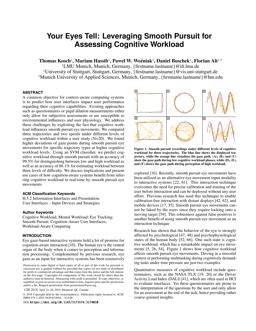A common objective for context-aware computing systems is to predict how user interfaces impact user performance regarding their cognitive capabilities. Existing approaches such as questionnaires or pupil dilation measurements either only allow for subjective assessments or are susceptible to environmental influences and user physiology. We address these challenges by exploiting the fact that cognitive workload influences smooth pursuit eye movements. We compared three trajectories and two speeds under different levels of cognitive workload within a user study (N=20). We found higher deviations of gaze points during smooth pursuit eye movements for specific trajectory types at higher cognitive workload levels. Using an SVM classifier, we predict cognitive workload through smooth pursuit with an accuracy of 99.5% for distinguishing between low and high workload as well as an accuracy of 88.1% for estimating workload between three levels of difficulty. We discuss implications and present
use cases of how cognition-aware systems benefit from inferring cognitive workload in real-time by smooth pursuit eye movements.
use cases of how cognition-aware systems benefit from inferring cognitive workload in real-time by smooth pursuit eye movements.
Publikation
 |
Thomas Kosch, Mariam Hassib, PawełW. Woźniak, Daniel Buschek und Florian Alt. Your Eyes Tell: Leveraging Smooth Pursuit for Assessing Cognitive Workload. In Proceedings of the 2018 CHI Conference on Human Factors in Computing Systems. CHI '18. ACM, New York, NY, USA. [Download Bibtex] |